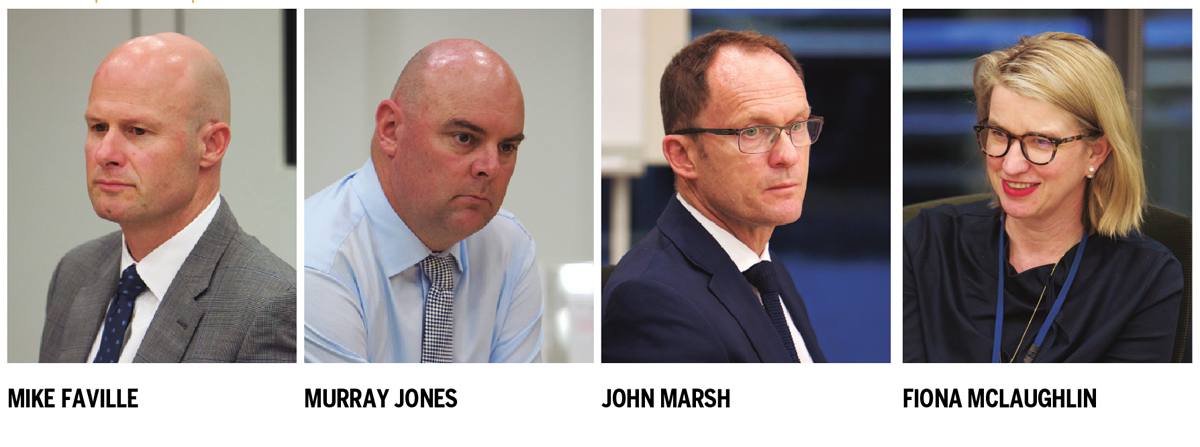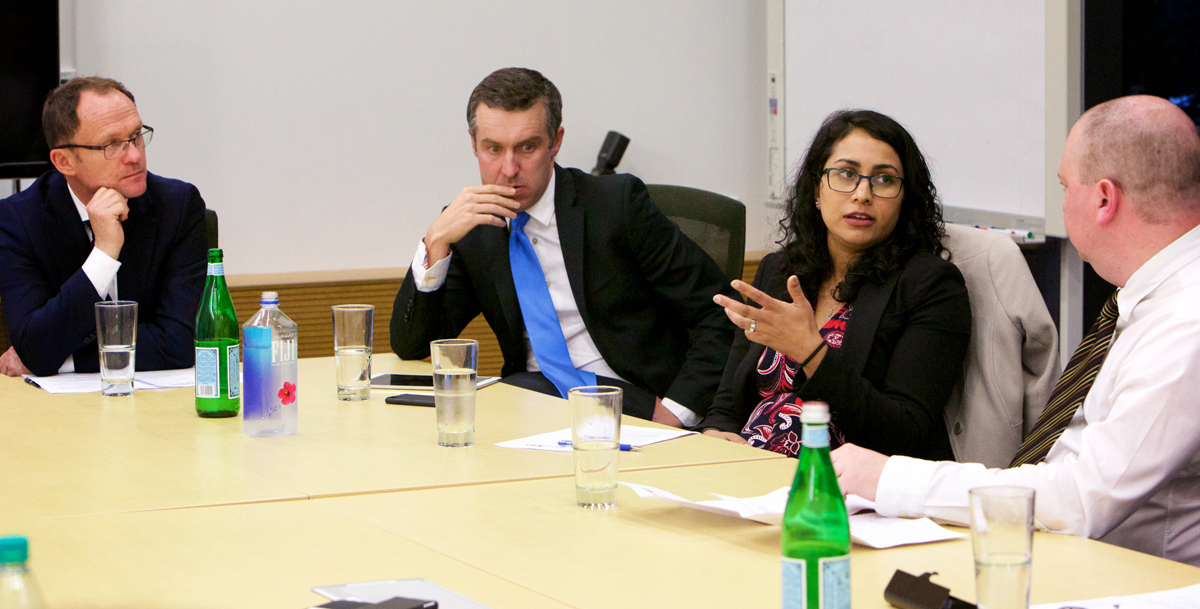
New Zealand's game changers
The biggest issue in the New Zealand debt market has historically been shortage of domestic supply relative to a demand pool that has grown significantly in the KiwiSaver era. In September, BNZ and KangaNews convened their annual New Zealand roundtable with a specific goal in mind: to discuss whether the national infrastructure need, the emergence of bank securitisation and other factors can radically change the supply landscape.

GROWTH OUTLOOK
Davison The hypothesis we’d like to discuss is that New Zealand could be close to an inflection point in the evolution of its capital markets, in the sense that – for the first time – there is real potential for a supply boom to satisfy the growth in demand KiwiSaver has driven. What is the big picture?
More recently, regulatory changes for banks have meant more demand for high-quality, liquid prudential assets. Crown assets have also continued to grow. In total, we think local assets in the debt market are around NZ$95 billion (US$63.6billion) – including a KiwiSaver component that has grown from zero in a decade.
At the same time, the banks have been terming out their own funding and a good chunk of this has been issued domestically. The Crown has been issuing more since 2011 and the New Zealand Local Government Funding Agency (LGFA)entered the market in 2012. We also saw the birth of the high-grade Kauri market in 2007.
Our analysis is that KiwiSaver got to full adoption in roughly 2015 but contributions continue to grow as the early adopters have risen through the pay scale. There is every reason to think the asset growth we have seen – of about NZ$6 billion of new member contributions a year – will continue even though the adoption process has largely played out. Banks’ prudential balance sheets will also grow with system growth.
There is a lot there telling me the NZ$95 billion we already have invested in debt domestically will continue to grow. But it is not so clear that recent issuance patterns will support this growth.
For instance, the New Zealand Debt Management Office (NZDMO) is forecasting only a small increase in net debt issuance over its forecast period to meet the Crown’s needs. Meanwhile, the Kauri market has record maturities over the coming years so significant issuance will be required to maintain supply let alone meet additional demand.
I think we are at an inflection point that will provide opportunities for issuers. We have already seen Housing New Zealand (Housing NZ) take advantage of this. Potentially, the likes of the LGFA, Auckland Council and local banks are well placed to meet ongoing investor demand.
BNZ PARTICIPANTS

Davison Do other market participants share the view that growth in demand is set to continue? What are the immediate prospects for supply?
On the outlook for local-government-sector debt, councils have just released their 10-year plans in which debt across the sector is projected to grow to about NZ$26 billion from roughly NZ$15 billion now.
This could be overstated because councils have historically been quite optimistic about their capacity to deliver infrastructure and hence their need to borrow. We would usually discount the projections by about 30 per cent, but this time we are only doing so by about 20 per cent. This is because there seems to be greater willingness from central and local government to get on and deliver infrastructure this time. We think there will be an increase in supply.
There is also a story about where the money will be going. Going into the forecast process, we thought all the borrowing would be in the “Golden Triangle” of Auckland, Hamilton and the Bay of Plenty – but this hasn’t been the case. There is demand across the entire country, and in fact Auckland’s debt as a percentage of the whole sector is actually projected to shrink a bit.
I believe Auckland is projected to be about half the new debt. We have some balance-sheet challenges and are knocking up against some debt limits, so we are also looking at other ways to do what we need to do.
It’s on the public record that Auckland Transport has more than NZ$5 billion of good-quality projects that we cannot fund. This is a way of saying these numbers aren’t pie in the sky – we are talking about real projects that have been proven and could in fact add to the number Mark Butcher is talking about.
Davison We’ve discussed shortage of supply in New Zealand for many years – so there shouldn’t be a shortage of capital available.
The issue for us really is a credit-rating preference at the sector level. We are the “shaky isles”, so it makes sense always to have some headroom in reserve for a rainy day.
There is certainly a conversation going on about why we can’t just borrow more. My response is that we could do a bit more but really it wouldn’t alleviate the problem. We could probably borrow another NZ$1 billion, but that would really just be a nudge when we could easily use NZ$5-10 billion productively. The issues are more profound than New Zealand is used to, and we need to look at fundamental shifts rather than tweaks.
Davison This seems to be a good moment to ask about the supply perspectives of infrastructure specialists. Can New Zealand capital markets expect to see a leap forward in infrastructure-related supply?
HRL Morrison & Co runs three infrastructure funds that focus largely on public-private partnerships (PPPs), mostly in New Zealand. These represent NZ$260 million of equity underpinning NZ$2.6 billion of infrastructure – which shows how equity can work alongside debt in this sector. But it’s harder to deploy this type of capital nowadays, and we are not sure how it will work in future.
Our view about transaction supply going forward is that we will have to be more creative to invest funds, looking at alternative means by which we can work with – for example– local government to put capital to work without necessarily having the central-government backing we would in a traditional PPP.
Having said this, the government has signalled its intention to deliver major infrastructure projects – for example, Auckland Light Rail – and it has also recently announced an independent entity to provide expert advice, planning and strategy to support the delivery of major infrastructure projects across the country. This is potentially a positive sign for the PPP market.
The new policy environment also changes the equation when it comes to infrastructure development, in the sense that while there might still be debt-financing opportunities it will likely be harder to place equity capital.
Davison Does Accident Compensation Corporation (ACC) mainly focus on equity?
Butcher Does ACC have a minimum size of transaction it will look at? New Zealand has had an issue around the limited scale of some of its PPP projects – that they aren’t big enough to justify going down the contestable route.
Davison On the point about most New Zealand infrastructure being owned by local councils, is the asset-recycling model that has been used in Australia – where states have sold or leased assets to fund new ones – on the table in New Zealand?

DEMAND CHARACTERISTICS
Davison It would be interesting to get a view on the supply outlook from fixed-income investors. Is New Zealand reaching a point where the buy side can be more optimistic about the domestic supply outlook?
The challenge is around cost, specifically a reluctance to adopt structures which could ultimately deliver more scale for New Zealand and diversified supply for capital markets but which come at higher cost.
The preference to date is to fund via Crown agencies. Scale is still limited under this model as rating agencies will ultimately look through the structure to the Crown balance sheet, which raises the issue whether the Crown should fund directly.
This is the big challenge politically. The solution requires us to move away from wanting our cake and eating it too: we want the assets, but don’t want to burden the taxpayer further.
We are unlikely to have significant demand barring a desire to increase our portfolio allocation to very high-grade assets at the expense of higher-yielding assets. If the yield is only marginally better than swap investments, it may be more efficient for us simply to receive swap than to allocate credit resources to low-margin assets.
Overall, my sense is that we are in the infancy of market development in this area. But I don’t think we are at a fork in the road quite yet, at which we must decide for all time which funding formats will be used. It will be more of an iterative process, whereby projects are aired and funding options discussed between market participants. This is typically how infant markets work.
We would welcome the opportunity to work with participants in this space and to help find solutions that work for both parties. Our flexibility allows us to look for less vanilla outcomes than simply high-grade bonds, should the opportunity require it. This could involve unrated securities, subordinated financing or private transactions – including investing directly with borrowers.
Davison The suggestion here seems to be that the New Zealand buy side isn’t specifically asking for new supply to come in the form of double-A rated, quasi-sovereign bonds. Is that fair?
MARKET-FRIENDLY SOLUTIONS
Faville The Clean Energy Finance Corporation (CEFC) has essentially taken the role David McLeish describes in a number of projects in Australia – taking the equity piece to facilitate wider capital-markets support. How does this work?
We have done a number of things towards this goal. We have partnered with leading players in the space as providers of equity, either to enhance their sustainability credentials or to seed structures and funds to invest in the sector in a way that meets our mandate.
We are able to invest anywhere in the capital stack. To date we have not participated in semi-government green-bond issuance, for a range of reasons. Other than this, we have invested across the spectrum from early-stage venture-capital equity to high-investment-grade debt.
Some of the points Vicky Hyde-Smith raises are similar to what we have heard around infrastructure investment in Australia, particularly at state level. The states are rating constrained and Australia has struggled to overcome resistance to making people pay for infrastructure through other mechanisms. There is a lot of talk about value-capture mechanisms, for instance. These are, arguably, innovative and they might get projects off government balance sheets, but they are fundamentally inefficient.
We have tried to identify transactions and structures that are essentially commercial but where the deal needed a push along on some specific factor, especially where banks – domestic and foreign – were struggling. This could be tenor extension or capital position.
Davison Our sense, in the debt market, is that the CEFC has been particularly successful at giving third-party capital confidence that a transaction will go ahead and is therefore worth devoting resources to.
When we provide cornerstone bids now it is to try to persuade issuers to come to market. We are supply-side constrained in Australia, with growing and significant demand for any sustainability-related fixed-income asset. Our job is to try to get issuers over what are essentially technical issues such as the hurdle of paying a relatively modest amount to have a transaction certified as sustainable.
Davison If there is limited desire – on the borrower and investor side – for lots more quasi-government debt to fund infrastructure, and the policy environment for PPP-type funding has weakened, how can the market fund infrastructure?
But it doesn’t give transparency on the deal side. I think better things happen when there is some project-finance discipline involved. This is principally because who is paying becomes very clear, as are the incentives to risk owners. Centralised funding incentivises us to build things but not necessarily to do so smartly.
We are starting to do more things in the project-finance space and I am an advocate of this. It has to be a balance, because these initiatives are tough – but it also has to be part of the way we progress.

What this meant was the project was able to be presented to the market with the development risk taken care of, so private capital could come in – in the form of senior debt – from commencement. In doing so, all the senior debt was subscribed from day one.
What I’m interested in is whether something like this could work, on a policy level and in the market, in New Zealand. It seems to speak to Matthew Walker’s point about transparency, in the sense that how it is paid for and how risk is assigned is clear from the start.
Given our mandates and benchmarks, our natural area of interest is likely to be the senior debt within structures. We may also be less comfortable with incredibly long-dated debt absent additional compensation for illiquidity.
To commit our resources to a project like this, what we would need to see is a reputable entity with infrastructure capability working with key government departments to develop the solution successfully, and ultimately being prepared to take – and be compensated for – the equity risk.
If there is cornerstone involvement with parties that clearly have the specialist skills to drive project success and certainty of ongoing supply, I agree there is no reason why other participants can’t be attracted into various parts of the structure that align with their investment goals.
When it comes to joining the dots across the capital spectrum, what I’d suggest is that capital hunts in packs – or at least in pairs. Bring equity and debt together to have a look at projects, because there is uncertainty in these projects based on the fact that you have to take a two-decade-long view.
Davison Is liquidity an issue for debt investors when it comes to infrastructure?
I don’t see liquidity as an issue in mezzanine or sub-debt tranches. I don’t think anyone would class liquidity as a key driver of an investment decision at this level of the capital structure, and I think there is an inherent understanding that there isn’t much, if any, secondary market for a piece like that.
It comes down to understanding the assets being financed and each investor deciding what, if any, role they want to play in these typically long-term and often illiquid markets. Certain pools of the capital we manage may suit this type of financing and the size of these pools may be meaningful enough to help get these discussions underway.
The role of sustainability in infrastructure development
New Zealand will soon have its own Green Investment Fund, with a mandate to catalyse further investment in climate-change-related projects. As New Zealand infrastructure investors look at their own sustainability criteria, there is a useful precedent in Australia.
LOVELL It is challenging, but it has become easier to find appealing investment options as we have moved to a more stable position from a regulatory perspective. When I joined, three-and-a-half years ago, our then chief executive expressed doubts to me that we would ever commit our full allocation of A$10 billion (US$7.3 billion). We are now well over half way including commitments of A$2.3 billion last year alone.
Crowding in capital is an ongoing task and we judge transactions on this basis. Itis actually getting increasingly hard to do but we make great efforts in this respect. To attract additional capital you have to demonstrate a value proposition – investors don’t just give entities money for green funding because it’s a sexy thing to do.
We are in the process right now of examining the best ways to crowd in capital. What I will say is that we now have a five-year track record of investment we can point to. This has been a net positive for the Australian taxpayer.
Regarding New Zealand, the fact that crowding in is tricky means I think it is vital that the local organisation is given sufficient scope and flexibility to make things happen. Managing 10:1 leverage is tough even if you are able to achieve it, because you can only serve so many masters.
BOND-MARKET RIPPLES
Davison The NZDMO is looking at a reduced net new-issuance forecast. Do investors ask why the infrastructure requirement isn’t being funded by central government?
Over and above this, investors of course have their own preferences – largely driven by their mandates – on what sort of supply they would prefer to see. Some mandates are very restrictive and these investors would generally prefer to see more NZGB issuance. Equally, some investors would like to see a much more diverse pool of New Zealand dollar assets.
Davison The NZDMO is also working with a relatively new government. Has this changed the debt-issuance strategy?
One recent change in our issuance strategy has been in the way we think about Treasury bills. We are taking a more flexible approach to issuance and mainly using them for liquidity purposes.
Davison Housing NZ has made a successful return to debt issuance with a relatively straightforward government-agency model. Was any thought given to alternative funding methods, given the infrastructure-type nature of its task?
Our focus was ensuring a successful re-entrance to market, having not issued since the late 1990s. We focused on the high-grade space and emphasised our strong creditworthiness, given our credit rating is equalised with the Crown.
We aren’t offering significant credit diversification compared with some of the infrastructure projects we have discussed, but we are offering a material net new supply of high-quality bonds.
Davison Did Housing NZ get asked why it was needed as an entity by investors, rather than all the funding being done by the Crown via the NZDMO?
We highlighted how Housing NZ is a unique prospect compared with social housing providers globally, particularly given its critical role and integral link to the Crown. Investors certainly understood the importance of what we are trying to achieve, with debt raised for building to house New Zealanders. From a credit perspective, given the limited number of high-grade domestic issuers, it was natural for investors to compare us to the LGFA.
This was the focus of the conversations we had, rather than why we were in the market. That’s not to say the question didn’t come up, and we welcomed the opportunity to tell our side of the story. In a nutshell, there is a small difference in the cost of borrowing under our own name versus seeking loans from the Crown, but the benefits offset this in our view – even if they are a bit nuanced.
The key benefit for us relates to our stewardship responsibilities to deliver on our asset-management plans, like any other provider of infrastructure assets. The renewal of our homes is lumpy and we are around 10,000 homes behind where we should be given lack of investment over the past decade.
We also drew attention to the cost reduction possible from the ability to lock in long-term contracts with suppliers, given certainty of financing.
SECURITISATION PROSPECTS
Davison The other major asset-class development on the horizon in New Zealand is a bank securitisation market. This seems to be getting closer, driven in particular by the Reserve Bank of New Zealand (RBNZ) – but is it something the banks themselves want?
First, while we don’t necessarily think the overall size of the capital market will increase we do think the makeup of product going into it will change. For example, we do about 25-27 percent of our wholesale funding domestically and it is virtually all senior-unsecured. If and when the RMO comes into play, overtime we will issue RMO securities instead of senior-unsecured bonds to some degree. The advantage here is that some of the senior-unsecured bonds are held by retail investors, and if we reduce issuance it will create a gap that can be filled by the likes of Housing NZ, the LGFA, corporate issuers and others.
We also know there are overseas investors looking for New Zealand dollar assets other than government bonds. An RMO security backed by prime mortgages should be attractive tothese investors, particularly those in Asia.
All in all, I think the RMO is going to create a fundamental shift in the way banks issue domestically and I think it will happen a lot quicker than we had been expecting.
Davison Why do you think the RMO will cause a rebalancing of domestic issuance rather than increasing the domestic component?
We aren’t talking about increasing our wholesale funding gap. Most of our balance-sheet growth will be funded through deposits, because there is a very strong deposit market in New Zealand. What we’re talking about is how we refinance our existing facilities.
Jones If BNZ switches some or most of its internal residential mortgage-backed securities (RMBS) into external RMBS, will it increase your demand for alternative prudential assets?
Butcher Do you expect RMO securities will be a more expensive form of funding?

Davison Do fund managers expect to have natural and early demand for New Zealand bank RMBS as and when they start to be issued? If so, how would the degree of interest compare with senior-unsecured bank paper if securitisation substitutes for rather than supplementing senior issuance?
It is unlikely that the retail market could become comfortable with the RMO asset class. I see it as a product for professional investors. This said, it might be possible to create a pooled fund that gives retail investors access.
Marsh It seems that the RMBS market could be quite a big bang for New Zealand if we look at the amount of internal RMBS the banks hold. Could we be looking at something like NZ$15-20 billion being termed out into the public market?
Davison Presumably another challenge to building issuance volume would be the fact that RMBS amortises through its life and tends to have a relatively short – roughly three years, typically – weighted-average life (WAL)? It would be rolling off almost as fast as the banks can issue it.
The regulator has a strong desire to develop the capital market with another instrument and there is also support from the banks for this development. I think it will come sooner rather than later and investors will need to be in a position to look at it.
What we don’t yet know is what the net impact on issuance in the public domain will be, as I am pretty certain the banks will have substantial cross-holdings of each others’ RMBS. If we are only talking about NZ$5 billion of incremental issuance over 3-5 years, I think this is quite achievable in the context of local market capacity – even though it will be coming into a local securitisation market that is very small and only has a limited range of investors set up to deal with it.
Purdy Is the expectation with New Zealand RMBS that there will be a high-rated tranche and a residual, equity piece that the issuing bank will retain?
The interesting point is that New Zealand-based valuers don’t really know how to value the equity piece – so it would be nice to have an active market for RMBS equity notes to look at for pricing guidance.
Measuring success in a changing market
With so much potential for development in the coming years, New Zealand market participants at the BNZ-KangaNews roundtable share their views on what they would consider to be the signs of success.
BUTCHER Breadth of issuance– more issuers – and longer term being available. The New Zealand Local Government Funding Agency has bonds on issue with a longest tenor of 15 years, but retail-investor interest drops away from three years onwards.
Looking forward three or four years, it would great to have 5-7 new issuers active and to see the bond index extended to more like five years from the current 3.5 years.
I also think it would be good if the interest-rate and credit cycles turn and interest rates rise. It would make the asset class more appealing to retail investors. At the moment it’s hard to envisage a flood of retail money into the product at current levels.
MARTIN As well as funding the Crown at the lowest possible cost and with acceptable risk, we believe we also play a role in developing New Zealand capital markets through our activities. Equally, we could see some benefits coming the other way if we had a broader range of product and these were on the radar of global investors. This could only be supportive of New Zealand government bonds.

HIGH-GRADE ISSUERS YEARBOOK 2023
The ultimate guide to Australian and New Zealand government-sector borrowers.

nonbank Yearbook 2023
KangaNews's eighth annual guide to the business and funding trends in Australia's nonbank financial-institution sector.

WOMEN IN CAPITAL MARKETS Yearbook 2023
KangaNews's annual yearbook amplifying female voices in the Australian capital market.
















